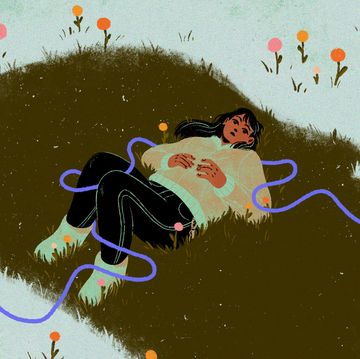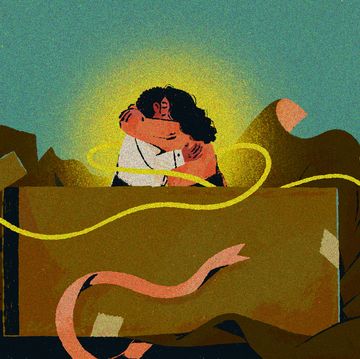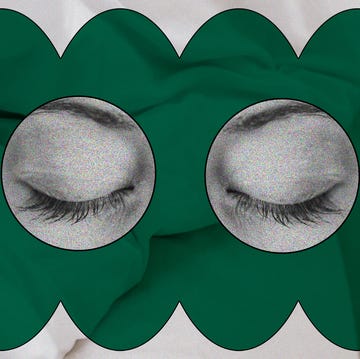Have you ever had an uninvited thought creep into your head that was so irrational, anxiety-inducing, or disturbing you wanted to shake your head until it fell out? And, when you least expect it, does that same negative thought reinvade your brain and psyche you out? If so, you are by no means alone. You’re simply coping with what mental health experts refer to as “intrusive thoughts.”
What are intrusive thoughts?
According to a post on the Anxiety and Depression Association of America (ADAA) website co-authored by Sally Winston, Psychologist and Founder/Co-Director of the Anxiety and Stress Disorders Institute of Maryland, intrusive thoughts are sudden onset “stuck thoughts that cause great distress,” often focused on scary, sexual, violent, or socially unacceptable images, or even thoughts that go against one’s belief system. They can be anything that strikes you as truly horrifying.
But the good news is, for most of us, these thoughts hold no significance whatsoever, and they can — and do — happen to everyone. “Everybody has thoughts that kind of go against who they are,” says Jonathan S. Abramowitz, Professor of Psychology and Neuroscience at the University of North Carolina at Chapel Hill, and an author of studies on intrusive thoughts.
Abramowitz says intrusive thoughts can be made up of all kinds of troublesome scenarios. “A normal intrusive thought would be, you're sitting around and your wife told you that she was going to be home by 4:00 and now it's 4:15. The thought goes through your mind — what if she had a car accident? You get an image of her body thrown on the street and broken glass everywhere. It's a terribly upsetting idea. Or, you're married or involved in an intimate relationship, and you think — what if I cheated on my partner? Or, people who are very religious will often have some sort of blasphemous image about who they worship, or about acting out in their house of worship,” he explains.
Why do we have intrusive thoughts?
Abramowitz says intrusive thoughts are just part and parcel of how our brains work. “It's one of those things your brain just does, like a natural exercise of some sort. We have thoughts about great stuff, like What if I caught the winning touchdown in the Super Bowl? Then we have thoughts about really dark, unpleasant stuff that we would never tell another person. That’s just normal. It's just how we work,” he says.
It’s whether or not you can move past these thoughts without developing rituals to try and combat them that can signal the difference between your regular, run-of-the-mill intrusive thoughts, and whether or not you are dealing with the possibility of anxiety-driven Obsessive-Compulsive Disorder (OCD).
“If someone has OCD, it will be very difficult to shake an intrusive thought out of their head,” explains Monnica Williams, Ph.D., clinical psychologist, Associate Professor and Director of the Laboratory for Culture & Mental Health Disparities at the University of Ottawa School of Psychology, and Clinical Director of the New England OCD Institute/Behavioral Wellness Institute in Tolland, CT. “They'll often worry that it is a true representation of a hidden desire or warning of a possible disaster. The person with OCD will then engage in some sort of behavior called a compulsion or ritual to exterminate the thought or reverse any actions they believe would happen as a result of the thought. Without the presence of compulsions, there is no OCD.”
Winston describes those who have OCD as having a “biologically pre-disposed stickiness” of the mind. “What gets stuck is definitely not random — it's the thing that offends you the most,” she says. “It's the opposite of a wish. The difference is not so much your diagnosis, it's your attitude towards the experience of the thought. If you're somebody who doesn't think a person should have them, then you can end up struggling with them.”
Abramowitz describes the compulsion to try to resist, push away, or misinterpret what he describes as “normal brain farts” as being something more important, bad, or meaningful, can send one into an anxiety loop. “The brain is supposed to respond to a threat by making us pay more attention to it as if it's a saber tooth tiger. The problem is it's a false alarm. I guess a good analogy would be, it’s not that the TV is broken, it's that you're watching the wrong channel. If you don't like the show that's on, the thing to do isn't to try to fix your TV. The thing is to learn how to change the channel,” he says.
Experts most commonly use Cognitive Behavior Therapy to help those with OCD break with intrusive thoughts and the ritualistic behaviors that stem from them.
Abramowitz says some of the tenets of Cognitive Behavior Therapy, or CBT, can be helpful in coping with intrusive thoughts. Though CBT is a blanket term that covers many different techniques, he specifically names Exposure and Response Prevention and Acceptance-Based Commitment Therapy as the most-effective research-backed treatments therapists use to help those with OCD deal with intrusive thoughts.
Winston herself uses what she calls “Third Wave” CBT, or Acceptance-Based CBT. “It's about not changing the thoughts or getting rid of the thoughts or modifying the thoughts. It's about changing your relationship with the thoughts, not moving into the content of the thoughts,” she explains.
To treat OCD, Williams mentions a technique called Exposure and Ritual Prevention, which involves gradual, repeated, and prolonged exposure to situations that cause anxiety until the anxiety fades. “The response prevention component involves learning how to stop compulsions or rituals. By stopping the compulsions, clients learn that rituals do not protect them from their obsessional concerns,” she explains.
How can we best handle intrusive thoughts?
Don’t push them away
If you’re bothered by a reoccurring intrusive thought, it helps to understand that resisting it can backfire. Your inner world doesn’t work the same way as the outer world, Winston explains. “If you want a table moved, you pick it up and move it or you push it. You put in effort, you get what you want. In the inner world, that kind of effort works backward. The harder you try to not feel something or not think something, it comes back double. Putting in effort is not the solution. What works is being willing to have [the thought] there, and then letting time pass,” Winston says.
The thoughts are not you
Once you fully grasp that your thoughts are inconsequential and are unattached to any intention or outcome, they don't matter as much. If they don’t matter as much, you stop worrying about them and stop anticipating that they will come back, explains Winston.
“Your level of sensitization goes down, because you have less dread and anticipatory anxiety. Because your level of dread and anticipatory anxiety goes down, it happens less often and eventually stops happening. It's a non-judgmental willingness to just let time pass as it will flow through if you don't make it (the thought) stuck by getting entangled with it,” she says.
Don’t overthink your thoughts
Winston advises against engaging with intrusive thoughts when they occur — just let them be. She also advises against analyzing them for significance or trying to figure out if they mean anything. Finally, she says checking in to see if you’ve had the thought is just a gateway back to the thought — so don’t.
When asked if other modalities of therapy might help intrusive thoughts, all three experts said CBT was the way to go. Other techniques, like Neuro-Linguistic Programming, or NLP, which uses affirmation-based techniques, might seem helpful, but Abramowitz mentioned a lack of research supporting its efficacy for intrusive thoughts.
“Affirmation can help helpful depending on how they are used. The problem is that people with OCD are likely to turn an affirmation into yet another compulsion, which only makes the OCD worse,” says Williams.
Abramowitz said Rational Emotive Behavior Therapy (REBT), a CBT technique that works really well for types of anxiety and for depression, isn’t particularly effective for intrusive thoughts. Dialectical Behavior Therapy (DBT) can be really effective for some problems with emotion regulation but is not a technique that would be used for intrusive thoughts, either.
Take care of yourself
Self-care helps. Exercise, eating right, and sleeping well are basic forms of self-care that don’t necessarily help intrusive thoughts specifically, but they do help with depression and anxiety, which can make people more vulnerable to intrusive thoughts.
When to get help
If intrusive thoughts dominate your day to the point that you can't get anything else done, and you notice they drive your behavior, Abramowitz says it might be time to reach out to a professional for help, especially if you’ve thought seriously about harming yourself or someone else.
“If those thoughts are exciting to you, make sense to you, and you agree with them, please talk to someone,” he says.
For more information about problematic intrusive thoughts OCD, please consult:
Anxiety and Depression Association of America
Association for Behavioral and Cognitive Therapy
Vivian Manning-Schaffel is a multifaceted storyteller whose work has been featured in The Cut, NBC News Better, Time Out New York, Medium and The Week. Follow her on Twitter @soapboxdirty.
Get Shondaland directly in your inbox: SUBSCRIBE TODAY














